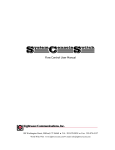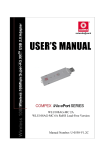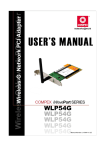Download Exemplar website project - Teacher commentary
Transcript
ai. Definition a(i)a. Definition: a brief description of the organisation or group that has the problem and an introduction to the client and/or the end user(s) and their place within the organisation or group. a(i)b. Definition: an outline of the problem that needs to be solved. The candidate has provided a brief introduction to the organisation and client 1 1 1 2 1 2 The candidate has explained their reasoning for conducting an interview, the 2 venue, place and time have been clearly organised and communicated with the client. Evidence of communication with the client is in the form of emails. 3 A range of questions have been planned, that cover the main areas: input, output and storage. The candidate has also considered system HCI and processing that is carried out within the current system. All questions have been justified and there are a number of follow up questions, showing that the candidate has thought about the possible responses they may get. They are awarded the 3 marks for this section. 1 2 aii. Investigation a(ii).a. Investigation: thorough planning of the mechanics of the interview situation. a(ii).b. Investigation: reasoned set of questions to elicit important information (possible responses have been considered and follow‐up questions have been planned). a(ii).c. Investigation: record of key responses of interview, demonstrating two‐way discussion. a(ii).d. Investigation: evidence of analysis of the current system or of likely problem areas, arriving at reasoned conclusions that will show evidence of being agreed by client. a(ii).e. Investigation: Information collected about the requirements of the new system. a(ii).f. Investigation: clear presentation of the information collected about the new system. The candidate has provided an overview of how the current system works at the moment. They have listed the range of problems experienced at present and have drawn some conclusions about the impact they can have on the department. Ideally the candidate would provide more discussion about the greater impact of the problems faced by the user. The candidate has conducted another interview with the client and also with the network technician to try and find out information about their requirements for a new system and how feasible it would be. In addition, documentation collection has been justified, stating why they would be beneficial in the new system development. A questionnaire could be handed out to the remaining members of the department find out their views and using the questionnaire data, graphs could be produced. The information has been clearly presented, however the calendar and timetable for clubs could be enlarged, so that the data can be read. 3 1 3 2 2 2 1 1 12 11 aiii. Analysis 3 3 3 2 a(iii).c. Analysis: a reasoned list of hardware and software requirements for the new system, providing clear justification for each choice in relation to the problem to be solved. The candidate has attempted to list all of the required hardware and 3 software and have started their list, by obtaining the minimum system requirements for their chosen software. Although all components have been listed, the server specification and desktop computer specification could be more precise, with actual requirements rather than minimum requirements being stated. They have however tried to relate each piece of hardware and software to the system requirements and have explained why they are needed. 2 7 a(iii).a. Analysis: Information collected about the requirements of the new system. a(iii).b. Analysis: a comparison of a number of different methods of solution, one of which may be the present solution and at least two others to allow a reasoned decision to be made in consultation with the client. The candidate has covered all main areas of the new system in their requirements. The requirements are specific and where data storage is concerned, fields have been listed. All requirements are specific and they seem to link back to the investigation. However, it would be useful for the candidate to try and cross reference each requirement back to the investigation, for example, by adding an interview question number by each of the requirements. The candidate has discussed each of the different methods that could be used and they have then gone on to discuss feasibility, the extent to which each method meets the requirements and cost implications. Although they have discussed the requirements generally, the candidate should really cover each requirement individually for each of the different methods. They have identified the chosen method and provided client confirmation in the form of a signature. Ideally a letter/email to and from the client would be useful, to show that they have been consulted about the different solutions, with each method explained in full. The candidate is awarded 2 marks, due to a number of requirements not being discussed. 9 b. Design b(i).a. Nature of the Solution: Design of data handling, including capture, The candidate has provided table designs for their database, flow charts, a website structure diagram and list of processes. Entity Relationship diagrams preparation and storage, to include map and diagrammatic should be shown, but in this instance, the database does not have linked representation of links where relevant. tables. The candidate could also provide some data flow diagrams and a website navigation diagram, to show how pages are linked together. As this is an important aspect of the website design, the full marks are not awarded. The candidate has provided designs for the following aspects of the website: b(i).b. Nature of the Solution: design of inputs, queries/processing and outputs, including error capture reports as appropriate, based clearly on CSS code specification, template design, pages and a description about what each one does, security consideration, drop down box contents and error the analysis of the client requirements. messages. It looks like the candidate will be using coding to connect to a database, when entering, editing, deleting and searching for data. For the designs of this, it would be beneficial to see how the code would need to be amended, for their system to work as intended. Due to this omission, the candidate is awarded 3 marks for this section. The candidate has clearly shown the client their designs and feedback has b(i).c. Nature of the Solution: clear evidence of iteration and development of designs in the form of annotated drafts; where relevant been obtained. As a result, the candidate has redesigned a number of this should include feedback from the client and evidence of how these aspects and they have again been shown to the client for further feedback. have had an effect on the solution. All aspects of the system have been considered in the development of the b(i).d. Nature of the Solution: a test plan that will identify a number of tests that will be carried out on completion of the work. All requirements test plan: input tests, visual tests, navigation tests and requirement tests. should be tested. The specific test to be carried out should be included in The candidate has also developed a questionnaire that could be given to the client. We would expect to see some more validation testing on the input the plan together with the result expected. (Some elements of testing should involve the end user(s)). test plan, including invalid and extreme testing, however it may not be possible with all systems and the candidate has attempted to carry out at least 1 invalid test. Each test has been clearly described, with sensible input data identified. Each test is also numbered, using an easy to use reference system. b(ii) Project Plan: Clear description, diagrammatic or otherwise, of the The candidate has only included the development and testing elements of different tasks necessary to complete the solution and a clear timetable. the project, which is the correct thing to do. They have included all aspects of the system development and testing along the way. The diagram could be bigger in size, as it is difficult to read. 4 3 4 3 1 1 4 4 13 2 11 2 2 2 c. Software Development, Testing and Installation The candidate has developed a system that seems to work very well. The 8 have provided evidence of all pages and in the case of query results, they have tried to show the varied outputs that can occur as a result of the searches. They have also explained each page, what it is used for and how it works. PHP, CSS and HTML coding have been provided by the candidate for all pages, but there is no explanation of how it works, which is a shame. The candidate has clearly customised the interface, but an explanation of the code would prove that they fully understand the system they have developed and how it operates. They do however explain each page, so this does give some explanation into the system. The candidate has also provided evidence of the database, including tables and data. The connection made to the database can also be seen via the PHP coding that the candidate has provided. Finally, the candidate has provided evidence of the website file structure. If the code were annotated, this candidate could be awarded the full marks, but due to their omission, 6 marks have been awarded. 2 c(i).b. Software Development and Testing: evidence of the development The candidate has shown how the data entry system works and has of one aspect of the system that processes data. provided a range of screenshots and annotation to explain the process that occurs. This would be sufficient to be awarded the 2 marks. The candidate has also demonstrated a second process below, but this is not a requirement of the marking point. The candidate has customised their system, following the company house 2 c(i).c. Software Development and Testing: hard‐copy evidence of an style. They have ensured that every page follows the same layout and pages effective HCI with annotations explaining its effective solutions for problems that had been highlighted in the requirements specification. are consistent. The candidate has used drop down boxes and check boxes to try and limit user input and provide a form of validation. They have provided an explanation to the user regarding what each page contains and users are clearly notified when they try to access a restricted area. The candidate has also added onscreen instructions to the user, explaining how to use the search facility for example, or the data format that should be entered when submitting data via a form. It would be good to see a little more onscreen support for the user, in the form of an online user guide link and further prompts, but the candidate has clearly demonstrated their customisation of the HCI and their evidence has been annotated, explaining how the system operates to meet user requirements. c(i). a. Software Development and Testing: 6‐8 marks: the candidate has solved a problem that has needed a level of complexity greater than a simple linear type solution; 3‐5 marks: the candidate has attempted to solve a problem that has needed a level of complexity greater than a simple linear type solution and has been successful in some aspects; 0‐2 marks: the candidate has produced a solution that is a linear style of solution in the use of software 6 2 2 c(i).d. Software Development and Testing: evidence that each of the tests specified in the test plan have been carried out, that they are linked to the hard copy evidence, that the results have been analysed and that any necessary action has been identified.( c(ii).a. Installation: details of the training that will need to be available for the staff who must use the new system. c(ii).b. Installation: details of the means by which the new files are going to be created, including some indication of the scale of the problem, and also the possible need for hardware installation and the installation of the software on the hardware. c(ii).c. Installation: details of appropriate, different, methods of changeover explained so that the client can make a reasoned decision. The candidate has carried out all tests and input/output values have been clearly identified. They have discussed whether the test has passed or failed and why this is so. Although the candidate did not test the editing of the system, they have explained that the test was partially passed and an explanation was provided to explain the shortfall. It is easy to cross‐ reference tests back to the original test plan and user testing has also been carried out. The candidate has clearly outlined some sensible and viable methods for training the staff, with full details of what the training would involve and logistically how it would take place. The plans have been communicated with the client and are detailed. The candidate has not only discussed the hardware and software required, but they have also considered the files that will need to be transferred before the system can be fully used. They talk about the time considerations for transferring data, as well as the method used to enter the data and volume of data. The candidate has provided the four different changeover methods and they have been customised towards the client’s system. They have discussed the different options with the client and a signature has been obtained to show their agreement with the plan. Instead of a signature, the candidate could also include a letter or email from the client. 2 2 14 3 11 3 2 2 2 2 7 7 d. Documentation d. Documentation: Mark Band 4‐7. Candidates will provide clear documentation. The documentation will be well presented. There is clear on‐screen help to support the end user. The supporting documentation and on‐screen help is well presented and covers most aspects of the operations that the user would be required to perform. Some subject specific terminology will be used. There may be occasional errors of spelling, grammar and punctuation. The candidate has demonstrated the onscreen help that has been provided 10 to the user within the system. The candidate could add more support to the user in the form of an online manual and more screen tips, to explain how to use the data entry form for example, but they have attempted to explain data entry requirements and page functions. The candidate has produced a well‐written user manual and their spelling grammar is good. The manual is presented clearly, with a good mix of written instructions and informative screen shots. Terminology has been used appropriately and the guide explains how to use both the front‐end of the system i.e. the web pages and also the back‐end of the system via a technical guide, explaining how to manage the database and content/appearance of the pages. Although the candidate has produced a project that could fit into the top mark band, there are a couple of areas that have been omitted and the user guide is therefore incomplete. The candidate has not explained how the CSS code could be updated to reflect changes to the house style. They have also failed to explain how to amend the table and form structure, if the needs of the department were to change in the future. 10 7 The candidate has included each requirement and has stated whether it was 4 passed or not. They have then discussed the requirement to try and explain how and where it has been met. In addition, they have discussed the system that they have created, including what it can do and who it has been aimed towards. The one requirement, which was not successfully completed, has been discussed, along with the reason for its failure. The candidate has provided an alternative option that could be used with the client, whilst the failure is rectified. 2 The candidate has clearly thought about the additional improvements that could be made to the system. They have provided a description of the improvement and how it would benefit the department and have also thought about the possible implementation of the changes. The candidate has looked back at their project plan and evaluated their use 2 of time for a range of tasks that did not go as planned. They have looked at the aspects that took longer than expected and try to provide an explanation into why this happened. 4 7 e. Evaluation e(a). Evaluation: Evaluation of each of the requirements from the requirements specification including showing how the completed solution meets the requirements. Areas from the requirements specification that have not been met are discussed. e(b). Evaluation: Details of extensions to the project and how these might be completed. e.(c) Evaluation: Evaluation of the finished development against the project plan from design. 2 2 8 8 f. Presentation of Report 3 1 The candidate has produced a well‐structured and navigable report. Page numbers are included and titles/subtitles clearly identify what is displayed on a page. The contents page is accurate and spelling/grammar used is good. Technical language is used by the candidate and is also used in the correct contexts. Although this project is written at a top mark band level, no log of events has been produced and this section can therefore only be awarded 1 mark. 3 1 Total: 80 68 f. Presentation of Report: The candidate has produced some material that explains part of the solution attempted. It will be difficult to navigate and will assume much knowledge of the solution that the reader will probably not possess. The information may be expressed without a structure. Errors of grammar or spelling may be intrusive.















